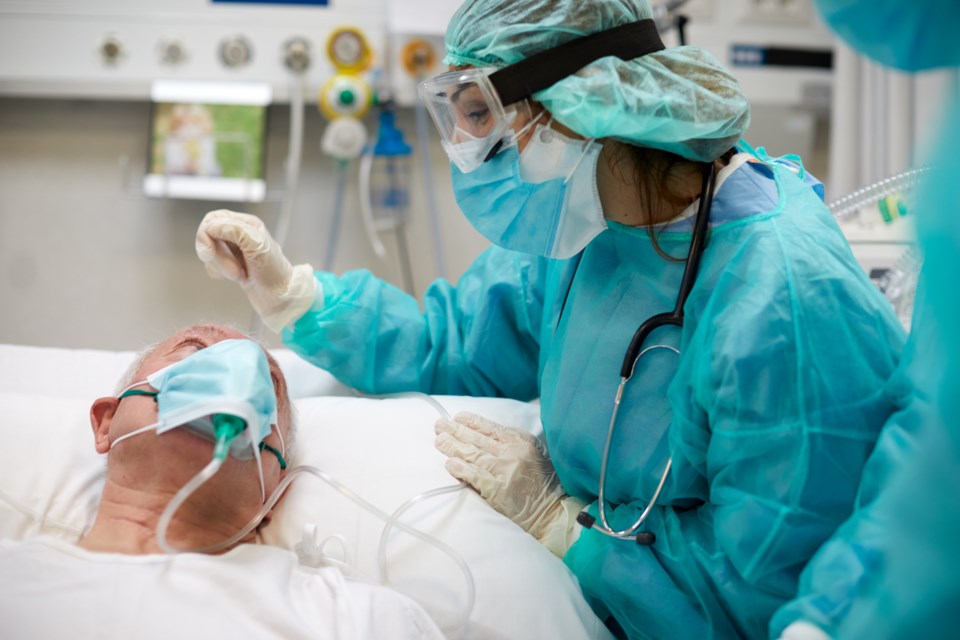Unvaccinated people with serious COVID-19 infections continue to push up occupancy levels at B.C. hospitals, and those facilities' intensive care units (ICUs).
Most of the 5,872 people actively infected with the disease in the province have been told to self-isolate, but 215 are now in hospitals, with 118 of those in ICUs. There have not been that many COVID-19 patients in B.C. hospitals since June 4. The last time more people were in B.C. ICUs with COVID-19 was on May 19.
Another three people infected with COVID-19 have died in the past 24 hours, raising the province's death toll to 1,827.
Health officials detected 671 new infections in the past day.
This rise is happening on the day before a long weekend, with schools about to resume on September 7. Last year, on this date, B.C. had 89 new cases for a total of 4,644 active infections. Of those, 34 were in hospitals, of which 11 were in ICUs.
Upcoming fall weather is also likely to drive more people into riskier inside environments for a greater percentage of the time.
More than 95.2%, or 160,268 of the 168,325 people known to have contracted COVID-19 in B.C., are considered by the province to have recovered because they have gone 10 days after first feeling symptoms, and are therefore not thought to be infectious.
Health Minister Adrian Dix said yesterday that he is concerned with rising numbers of people in hospital and in intensive care units (ICUs) with COVID-19.
Hospitals yesterday were below the 103.9% occupancy rate that staff grappled with pre-pandemic. The base-bed occupancy rate is 94.9%, Dix said. Additional beds created during the pandemic, known as surge beds, were at 12.8% occupancy. Some parts of the province, such as Northern Health and Interior Health, are harder hit than others, Dix added.
No new data was immediately provided for how many of the 671 new infections were in people who were unvaccinated.
The most recent government data on vaccination status noted that, between August 24 and 31, people not fully vaccinated accounted for 79% of cases, and 84% of hospitalizations.
The 4,861 cases in the week ended August 31 included:
• 3,345 (68.8%) unvaccinated;
• 496 (10.2%) partially vaccinated; and
• 1,020 (21%) fully vaccinated.
Of the 268 hospitalizations in the two weeks ended August 31, there were:
• 203 not vaccinated (75.7%);
• 22 partially vaccinated (8.2%); and
• 43 fully vaccinated (16%).
In the past 24 hours, health officials provided 14,549 vaccine jabs. Of the new vaccine doses provided, 6,856 went to unvaccinated people, with 7,693 others being second doses.
Of the 3,929,089 B.C. residents who have received at least one dose of vaccine, more than 90.9%, or 3,572,841 are fully vaccinated.
The B.C. government estimated in July that the province's total population is 5,147,712, so that means that more than 76.3% of B.C.'s total population has had at least one dose of vaccine, and more than 69.4% of the province's total population has had two doses.
The government's math holds that 84.8% of the province's eligible population, aged 12 years and older, has been vaccinated at least once, with 77.1% of eligible people being fully vaccinated.
Glacier Media crunched the numbers for how many of the 671 cases identified in the past day were in each of the province's health regions. The result for the number of new infections for each 10,000 residents (with total new cases in brackets) was:
• 1.3 in Fraser Health (230);
• 0.6 in Vancouver Coastal Health (78);
• 3.1 in Interior Health (230);
• 3 in Northern Health (89); and
• 0.5 in Island Health (44).
No new cases were in people who normally reside outside B.C.
The result by health region for the number of people fighting active infections for each 10,000 residents (with total new cases in brackets) was:
• 9.4 in Fraser Health (1,689);
• 8.6 in Vancouver Coastal Health (1,077);
• 28.5 in Interior Health (1,965);
• 19.8 in Northern Health (595); and
• 6.3 in Island Health (539).
One new outbreak at a B.C. seniors' living facility was at Menno Home in Abbotsford. That brings the total number of active outbreaks at healthcare facilities, or seniors' homes, to 21.



